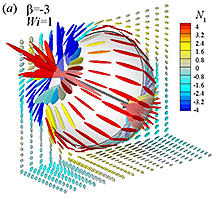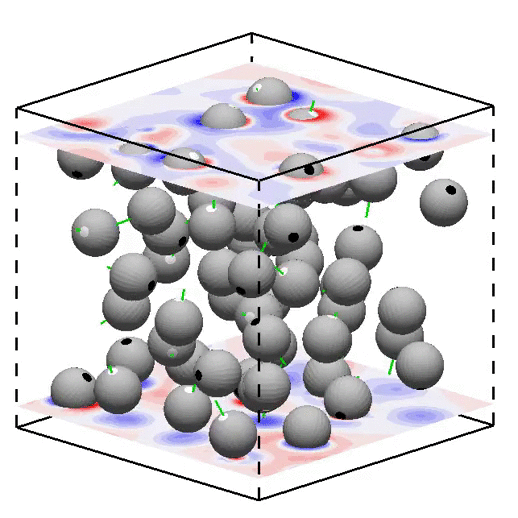Findings suggest how swimming cells form biofilms on surfaces
September 11, 2014
 |
|
This graphic illustrates how swimming microorganisms cause the stretching of polymers (elongated red, yellow and blue features) in a mucus-like substance, attracting the motile cells to surfaces in biofilms that foul everything from implantable medical devices to boat propellers. (Purdue University photo/ Gaojin Li and Arezoo Ardekani) |
WEST LAFAYETTE, Ind. – New research findings point toward future approaches to fighting bacterial biofilms that foul everything from implantable medical devices to industrial pipes and boat propellers.
Bacteria secrete a mucus-like “extracellular polymeric substance” that forms biofilms, allowing bacterial colonies to thrive on surfaces.
“They can form everywhere, on catheters used to transfer body fluids, prosthetic valves and other devices,” said Arezoo Ardekani (pronounced AH-Re-Zo Ar-de-KA-nee), an assistant professor in Purdue University’s School of Mechanical Engineering.
Costs associated with biofilms affecting implantable medical devices and various types of industrial equipment amount to billions of dollars annually. The slimy films grow on key surfaces in a range of applications, from boat propellers to the insides of industrial pipes, increasing wear and tear and fuel consumption and decreasing efficiency.
Attacking the biofilms using antibiotics and toxic chemicals has drawbacks including the evolution of antibiotic-resistant strains, which might be alleviated by finding ways to hinder bacterial adhesion without killing the bacteria.
Future approaches to controlling biofilms could hinge on discovering the precise motions of individual bacterial cells, which propel themselves using whip-like appendages called flagella.
Now, new findings reveal specifics about interactions that induce bacteria to swim close to surfaces, where they remain long enough to attach and form biofilms.
The findings appeared in a special early career issue of the journal Rheologica Acta, published on Aug. 31. The paper was authored by Purdue doctoral student Gaojin Li, former University of Notre Dame postdoctoral research associate Alireza Karimi, and Ardekani.
 |
|
This gif depicts the general swimming behavior of microorganisms as they approach surfaces. (Purdue University photo/ Gaojin Li and Arezoo Ardekani.)
|
The extracellular polymeric substance is sticky - or viscoelastic - and contains polymers such as polysaccharides, proteins and DNA.
The researchers are learning how the swimming mechanics of microorganisms are affected by these polymers as they draw near surfaces.
“Most research done on hydrodynamic interaction of bacteria on surfaces neglects the role of these polymers," Ardekani said. "And what we show is that this extracellular polymeric substance can also change the hydrodynamic forces that lead to bringing these cells close to the surface.”
The researchers studied the motion of motile organisms using a swimming model called a squirmer. The model allows researchers using computers to simulate three modes of propulsion employed by the microorganisms: pulling or pushing themselves using flagella either in the front or back, respectively, and neutral, in which tiny cilia are located around a spherical organism.
Most bacteria are pushers, and the findings showed that pushers swim closer to surfaces in the presence of the extracellular polymeric substance.
“They get closer and they stay closer as we increase the concentration of polymers,” Ardekani said
Such knowledge could lead to methods that hinder the ability of bacteria to stick to surfaces.
The research paper is available at http://link.springer.com/article/10.1007/s00397-014-0796-9.
The work has been supported by the National Science Foundation and the Indiana Clinical and Translational Sciences Institute Collaboration in Biomedical/Translational Research Pilot Program from the National Institutes of Health, the National Center for Advancing Translational Sciences, and a Clinical and Translational Sciences Award.
Writer: Emil Venere, 765-494-4709, venere@purdue.edu
Source: Arezoo Ardekani, ardekani@purdue.edu
ABSTRACT
Effect of solid boundaries on swimming dynamics of microorganisms in a viscoelastic fluid
G.-J. Li • A. Karimi • A. M. Ardekani
Purdue University
We numerically study the effect of solid boundaries on the swimming behavior of a motile microorganism in viscoelastic media. Understanding the swimmer- wall hydrodynamic interactions is crucial to elucidate the adhesion of bacterial cells to nearby substrates which is precursor to the formation of the microbial biofilms. The microorganism is simulated using a squirmer model that captures the major swimming mechanisms of potential, extensile, and contractile types of swimmers, while neglecting the biological complexities. A Giesekus constitutive equation is utilized to describe both viscoelasticity and shear-thinning behavior of the background fluid. We found that the viscoelasticity strongly affects the near-wall motion of a squirmer by generating an opposing polymeric torque which impedes the rotation of the swimmer away from the wall. In particular, the time a neutral squirmer spends at the close proximity of the wall is shown to increase with polymer relaxation time and reaches a maximum at Weissenberg number of unity. The shear-thinning effect is found to weaken the solvent stress and therefore, increases the swimmer-wall contact time. For a puller swimmer, the polymer stretching mainly occurs around its lateral sides, leading to reduced elastic resistance against its locomotion. The neutral and puller swimmers eventually escape the wall attraction effect due to a releasing force generated by the Newtonian viscous stress. In contrast, the pusher is found to be perpetually trapped near the wall as a result of the formation of a highly stretched region behind its body. It is shown that the shear-thinning property of the fluid weakens the wall-trapping effect for the pusher squirmer.

